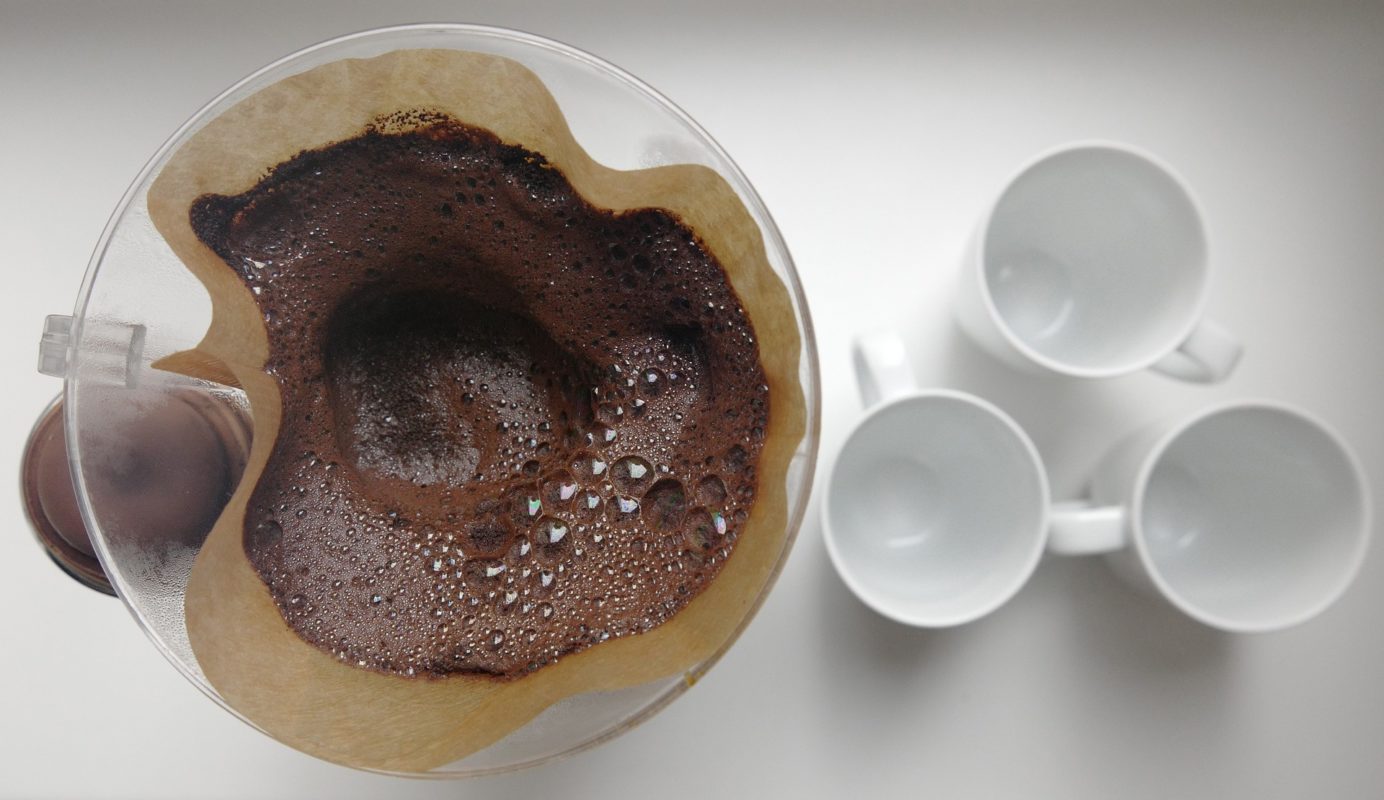At home, a cup of coffee is quickly conjured up. Thanks to the long-established routine in your own home, brewing with the coffee machine works every time, even if you are sleepy. But what if you don't want to miss out on your morning cup of black brew when camping in nature or at a festival? Fortunately, there are several alternatives that promise you taste and simplicity. But which outdoor camping coffee maker is the right one for you? We at VietBeans want to help you make a decision and present three options.
You don't have to go without your coffee when you're out and about. Especially in nature or at a festival, making coffee in the open air can be a delightful experience. Depending on your camping equipment and the environmental conditions, there are different ways to make coffee outdoors. Our article deals with variants of coffee preparation that require electricity, only need hot water or rely on an open fire or cooking facility. From the French Press on the traditional Vietnamese Phin Everything is possible, from the stove to the espresso maker. The aroma of freshly brewed, hot coffee is already in the cup. Is there anything better than a delicious coffee outdoors?
Coffee preparation with electricity
Motorhomes and campers are very popular. The mobile home offers comfort and at the same time the feeling of great freedom. Some motorhomes are downright luxuriously equipped, others are more deliberately minimalist. This also applies to the Making coffee using electricity from the socket .
This is easy at the campsite – but on the road? Two options there is: 230 volts as shore power analogous to alternating current at home and 12 volts as direct current just like with a car. Shore power always flows when your motorhome is connected to the power grid at the campsite. You can also use it to charge batteries and all sockets have electricity.
The You know 12-volt direct current from the cigarette lighter from the car, which you can also use to charge your mobile phone. Usually you need a additional adapter, to connect live devices. With an inverter you can get the 230 volt voltage.
Option 1: Travel coffee machines
Travel coffee machines depend on the intended use. For permanent campers Can you for longer stays in the same place are indeed worthwhile. But if you are on the move a lot, you should think about alternatives. The same applies to freestanding "wild campers": if you do not have a permanent power connection, you should resort to other options.
If shore power is available, everything from filter coffee to capsule machines is possible. You decide according to your taste and the space available. Special travel coffee machines work with 12 volts and also work on the go, but they take a relatively long time to make a relatively small amount of coffee. The power consumption is also very high.
If you want a fully automatic machine for your primary camping use, think about the noise level. The neighbors might complain if you're an early riser!
The Prices ranging from just under 30 euros to over 500 euros for machines with Electricity or battery operation and the usual costs for fully automatic machines and capsule machines.
Instructions
Coffee preparation in machines varies according to the manufacturer's instructions. As a rule, you put the appropriate amount of ground coffee beans into the funnel or the container provided and fill the tank with fresh, cold water. Many machines require extra filters. You insert capsules as usual. Fully automatic machines use whole beans.
The machine brews the coffee automatically. The quickest way to get your coffee is with a pad machine - it's ready in a maximum of three minutes. 12-volt travel coffee machines take the longest, with an average of 10 to 12 minutes .
You can use the type of coffee you like. For coffee lovers who have space in their motorhome, a coffee grinder can also be useful. These are also available with manual operation, so you can save a lot of electricity.
Advantages
- it's all like home
- comfortable because the machine works
- Coffee machines with thermos flasks keep the coffee warm
- Size and weight can be neglected if there is enough space in the kitchen area
Disadvantages
- the preparation time sometimes takes a very long time
- Capsule machines produce a lot of waste that has to be disposed of on the go
- Power consumption can be significant when travelling
- the coffee machine must be emptied before the journey so that nothing is spilled on the way
- Noise pollution must be taken into account for fully automatic machines
Forms of preparation that only require hot water
There are different ways to generate hot water when camping. You can electricity-powered with a Kettle work or have without electricity a wide selection: from gas cookers to the classic Spirit stove , the Esbit stove with fuel tablets until Hobo stove . You can also light a campfire.
CAUTION : When boiling water in the open air, pay attention to fire safety, especially near forests.
The cookers for outdoor use vary in weight, operation and performance. Gas cookers are available in various designs. These include devices that are operated with large, solid gas bottles and pocket versions with cartridges. Spirit cookers are also available in large versions for yachts and campers and as camping cookers. The heating output is lower than with gas cookers.
Esbit stoves work with a type of dry spirit in tablet form. The advantage is that they are light and easy to handle. The Esbit is well suited for heating small quantities. With the hobo stove you can quickly achieve high heating output. Heating is done with wood. The disadvantage is mainly the weight of the trekking wood stoves.
Option 2 of the camping coffee maker: The French Press
Much loved and used by many on a daily basis: the French Press. It is not only available made of glass for domestic use , but also for camping, festival and trekking in robust versions and different sizes .
Since the coffee powder goes into the container together with the water, no unnecessary waste is created, which is a big plus in nature. The container of the French press is usually made of glass, but there are also stainless steel ones available so that nothing can go wrong at the festival. You can also find a stainless steel French press in our shop . In addition: until the finished cup of coffee is in your hands, It only takes 5 minutes . The only drawback: only coarsely ground coffee is suitable for the French Press, unless you want half of the coffee grounds in your cup later. So either grind the beans coarsely yourself at home beforehand or buy ready-made coarsely ground coffee.
The prices for a French press range between 15 and 60 euros.
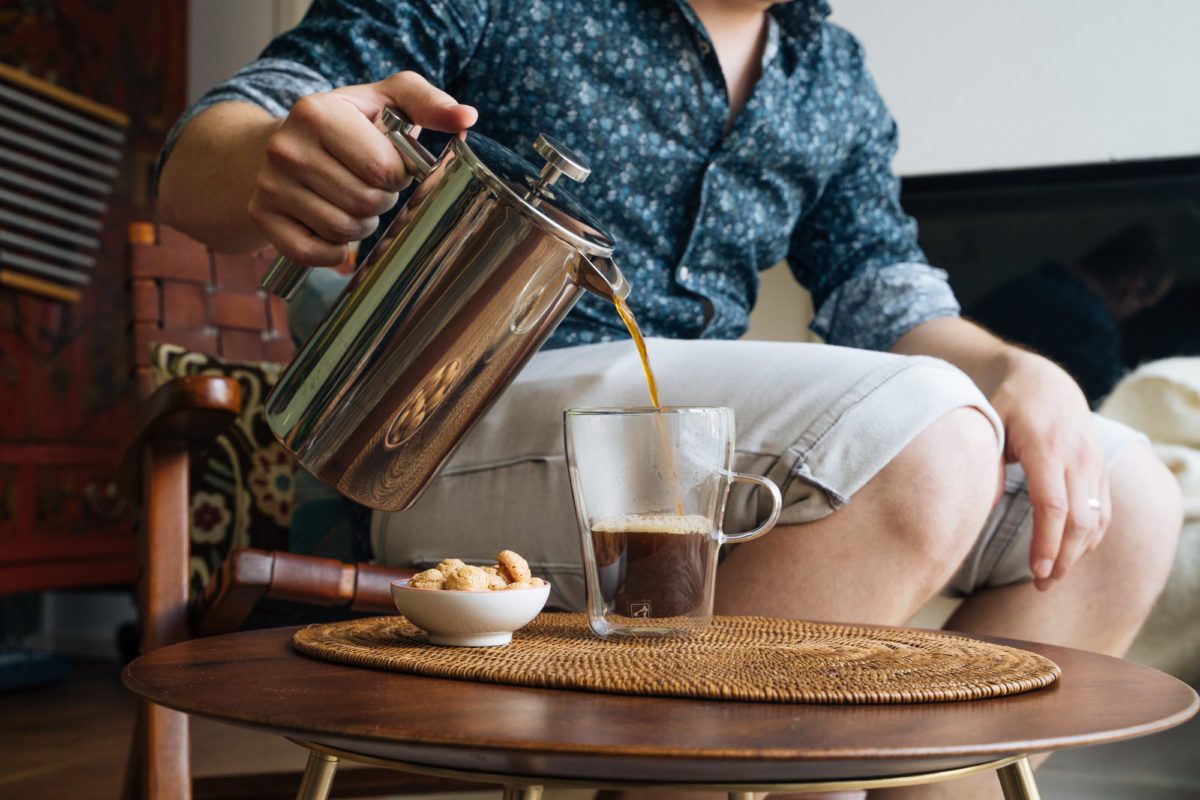
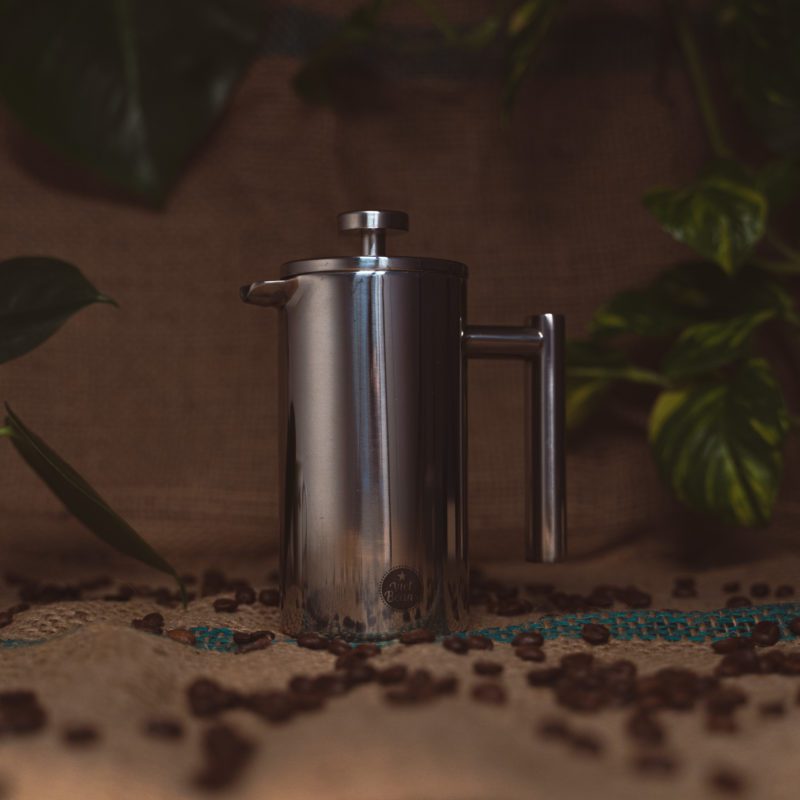
Instructions
- Heat water
- Put ground coffee into the pot
- Add water shortly after bubbling
- Put the lid on and press down slightly so that there is enough space
- After about 5 minutes of brewing time, press down the plunger lid and enjoy the freshly brewed coffee
Advantages
- no garbage
- quick preparation
- robust in the stainless steel version
Disadvantages
- Possibly too heavy and bulky for trekking and hiking
- coarsely ground coffee required
Variant 3: The Vietnamese camping coffee filter Phin
If you want to take a little exoticism with you in your motorhome, choose the hand filter from Vietnam . Similar to the French press, this camping coffee filter does not require any paper filters and is therefore very environmentally friendly. Another advantage is that it is small and handy and therefore fits in any luggage. The only thing you need in addition is a cup, which you probably have with you anyway. It is available in classic stainless steel or ceramic. Anyone who has ever traveled in Vietnam will be familiar with the metal filter that is placed directly on the cup and will be familiar with the meditative coffee preparation.
Our tip: Whether you're travelling comfortably in a motorhome or at a festival on the campsite - the Vietnamese coffee filter made of steel is robust, environmentally friendly (paperless use), easy to wash and is therefore ideal as an outdoor coffee maker. There is only one problem if you are travelling with a larger group. Since the hand filter can only brew one cup at a time, you either have to take several with you or everyone gets their coffee in turn. Since we have very cheap but still high-quality versions of the Vietnamese coffee filter in the shop at VietBeans , this shouldn't be a problem either.
The cost of the original Vietnamese coffee filter Phin are around 5 euros including a cup .
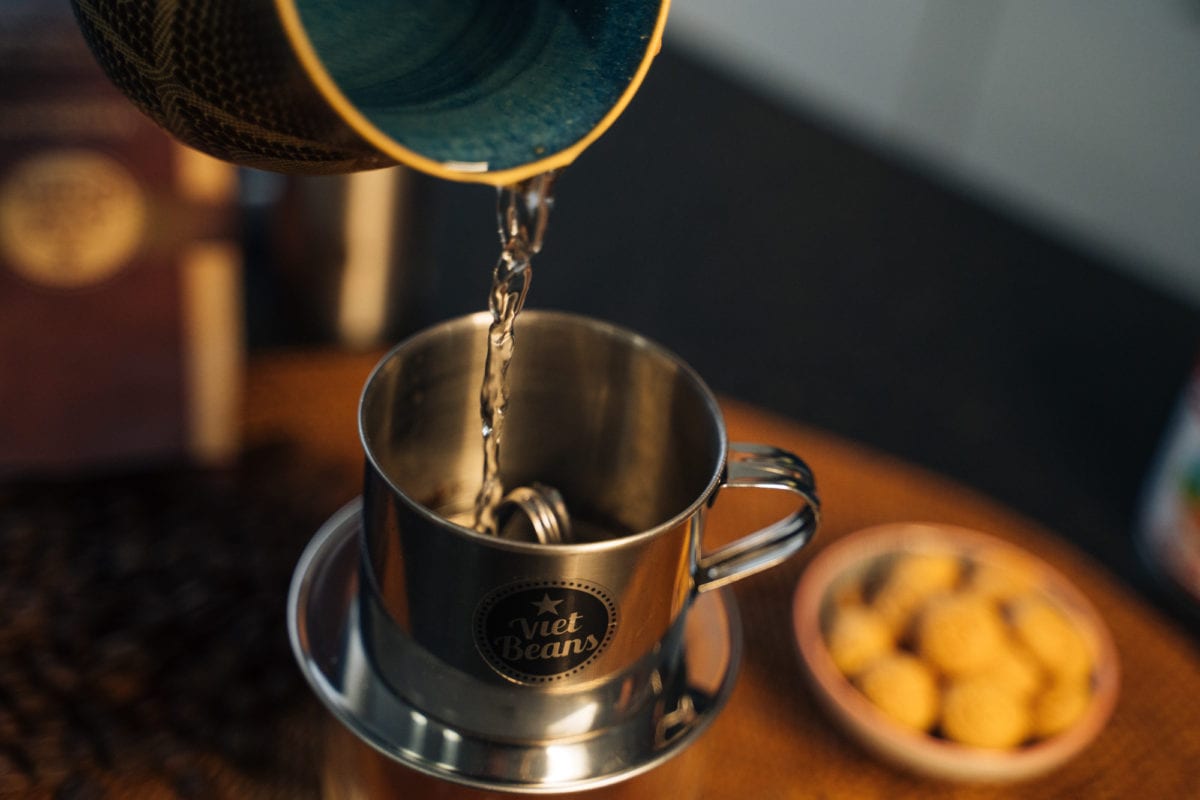
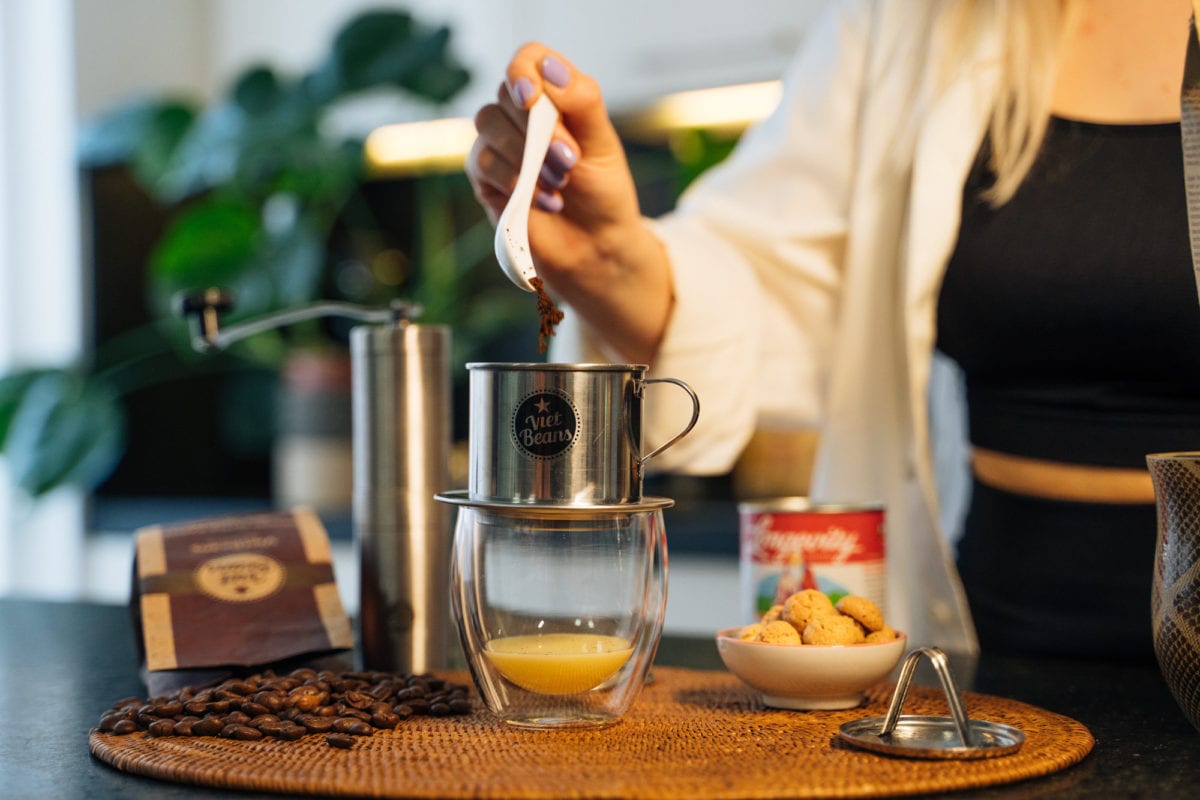
Instructions
- the Phin is placed directly on the cup
- About 2 tablespoons of coarsely ground beans are placed on the sieve
- Hot water is added so that the coffee can swell
- Pour in remaining water
- After about 2 to 3 minutes the coffee has brewed. Traditionally sweet condensed milk is added.
Advantages
- Environmentally friendly, as no paper filter is necessary (no waste)
- Quick preparation
- Robust as stainless steel or metal
- Small, handy & light
- Cheap to buy
Disadvantages
- just for one cup
- Caution is advised as there is no double-walled metal – risk of scalding
Variant 4: The Aero Press
This Camping coffee maker functions similar to the French Press , but has a additional filter so that finely ground coffee can also be drunk.
Coffee enjoyment with full aroma promises the Aero Press. The robust and durable device is made of food-safe polypropylene, which is free of phthalates and BPA. The piston seal and lid are made of silicone, the filters are made of paper. Cups are included. With the Aero Press you can use coffee filters when camping to enjoy finely ground coffee.
The Weight is about 450 grams , the Price at just under 30 euros . A Pack Filter with 350 pieces costs about 5 euros .
Instructions
- Add ground coffee to the brewing cylinder (about 14 grams)
- Pour about 50 milliliters of hot water over it and let it swell briefly
- Add 150 milliliters of remaining water, wait about 1 minute
- Place the plunger on the press and press together
- drain and enjoy
Advantages
- practical and easy to handle
- robust and durable
- can also be used for finely ground coffee
Disadvantages
- Filters must be purchased separately
Option 5: Filter coffee, the camping classic
You don’t want to miss out on filter coffee when you’re outdoors or on the go? With a Hand filters made of plastic, metal or ceramic A coffee filter is available for camping. You can use Chemex or the Carlsbad jug go travelling when you are travelling in a camper or you decide on a simple, sturdy coffee filter when camping .
Coffee filters differ slightly in their construction. Not all of them are suitable for every outdoor activity. If you are traveling in a camper van, you can use a glass Chemex or a ceramic Karlsbad pot. They are not suitable for backpacking. A simple coffee filter made of plastic or metal is recommended here. In any case, you will also need a filter. All types of coffee are suitable for filter coffee, and the coffee tastes milder and clearer through the filter.
All filters work according to the same Principle of the pour-over method . A Chemex Costs approximately 40 to 50 euros , a Carlsbad jug you get depending on the size for 60 to 90 euros , a Porcelain, plastic or metal filters approximately 12 euros .
A real option here is definitely the traditional Vietnamese variant, the Phin .
Instructions
- Insert filter paper
- 5 to 6 grams of ground coffee per 100 milliliters of water in the filter
- Pour about 50 milliliters of hot water over it and let it swell
- Add in a circular motion
- After 2 to 3 minutes the coffee is ready
Advantages
- available in very light versions starting from 60 grams
- durable
- mild taste
Disadvantages
- Filter bags must be purchased separately and disposed of
- textile filters such as the Japanese fabric filter must be dried
Option 6: The Nanopresso Espresso Maker Camping
Espresso on tour? A dream for many who travel with a backpack and tent. With the portable espresso maker Nanopresso it comes true and you get a freshly brewed espresso in front of the tent.
To make espresso you need pressure. Innovative technology makes it possible for you to enjoy a wonderful crema even when camping or staying overnight at a festival. Nanopresso offers the practical solution for backpackers. You can use all strong types of coffee. A Nanopresso costs you between 60 and 70 euros . With a Weight of just under 350 grams it does not put too much strain on you when hiking.
Instructions
- Fill boiling water into the tank
- Put ground coffee into the portafilter
- Unlock pump button and pump
- A maximum pressure of 18 bar is created in the piston
- Prepare a cup into which the espresso will flow
Advantages
- Camping espresso maker for trekking
- light and practical
- quick preparation
- no garbage
Disadvantages
- extra cup necessary
- only designed for one cup, but can be extended with extra kit
- higher purchase price
Option 7: Instant coffee
The quick solution where you only hot water need to make your coffee while camping is the Instant coffee . Not everyone likes its taste.
Instant coffee is soluble coffee made from dried coffee extract It contains less caffeine than regular bean coffee. It is easy to prepare and can be used in any container. Instant coffee is also available in liquid form as an extract with or without added sugar . Prices range between 1.50 euros for portion bags and 10 euros for 500 grams .
Instructions
- Add 1 to 2 teaspoons according to manufacturer's instructions or portion bag into the cup
- Fill with hot water, stir
Advantages
- quick result
- no additional accessories
- no waste (except for portion bags)
- inexpensive
Disadvantages
- possible taste disadvantages
- less caffeine than other preparation methods
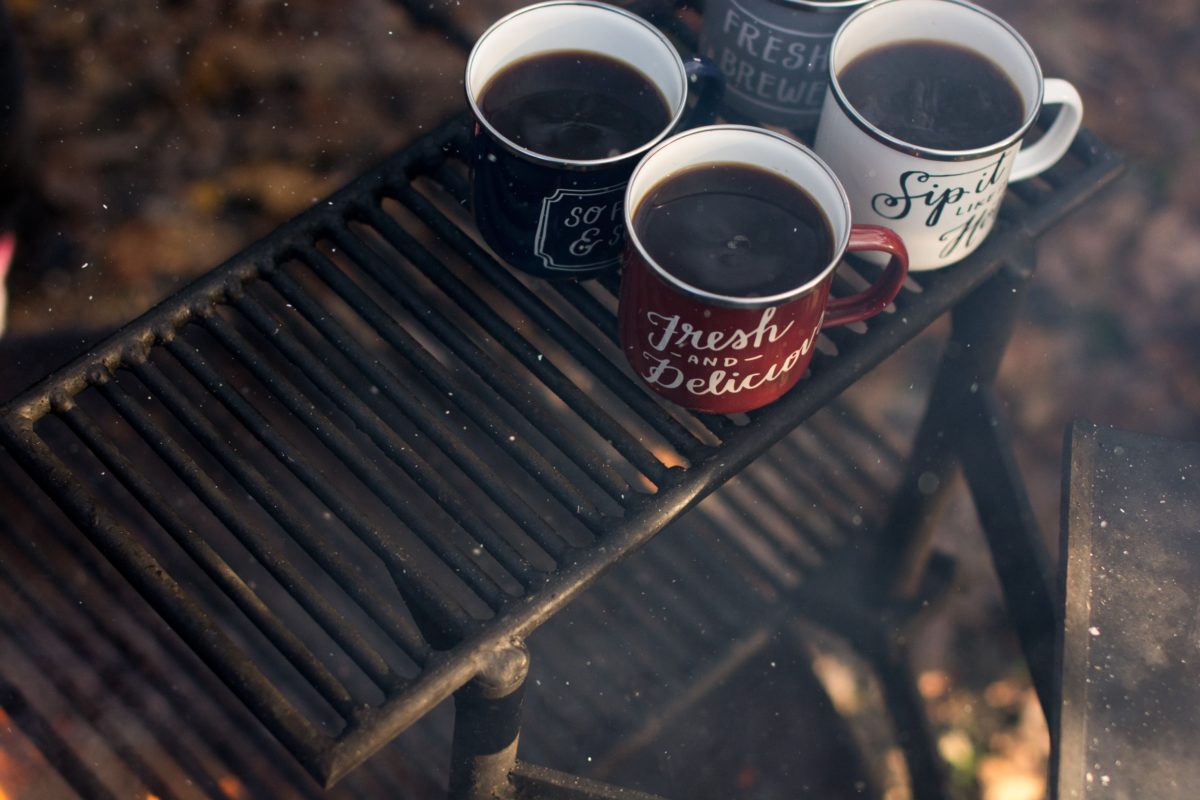
Coffee preparation at the fireplace or cooking area
Do you want to Espresso maker When camping, you need a open fire or a cooking facility . As with boiling water, gas cookers, spirit cookers with cartridges, Esbit cookers with fuel tablets and hobo cookers are possible, or you can light a rustic campfire. All you need is dry wood chips or some spirit and matches as well as a grate to make your Espresso maker or the Percolator to set up.
Variant 8 of the camping coffee maker: The classic espresso maker
The Espresso maker from Bialetti is probably the classic among coffee and espresso makers. With more than 300 million copies sold The sales figures speak for themselves. The espresso maker is made of double-twisted, high-quality and polished aluminum, has an ergonomic handle and is equipped with the patented safety valve. It can be used on all common types of stove (except induction stoves), including any classic camping stove or simply directly on the gas cartridge. In addition to being easy to handle, the coffee maker is also very easy to wash by hand - a big plus for camping trips. However, a name as big as Bialetti naturally comes with a corresponding price tag. Of course, that won't stop fans of timeless design from buying it.
Of course, you can also choose a different brand. When buying, pay attention to functionality and weight. Between An espresso pot costs between 20 and 50 euros . 240 grams weighs a one-cup cooker. For four cups you should expect about 500 grams .
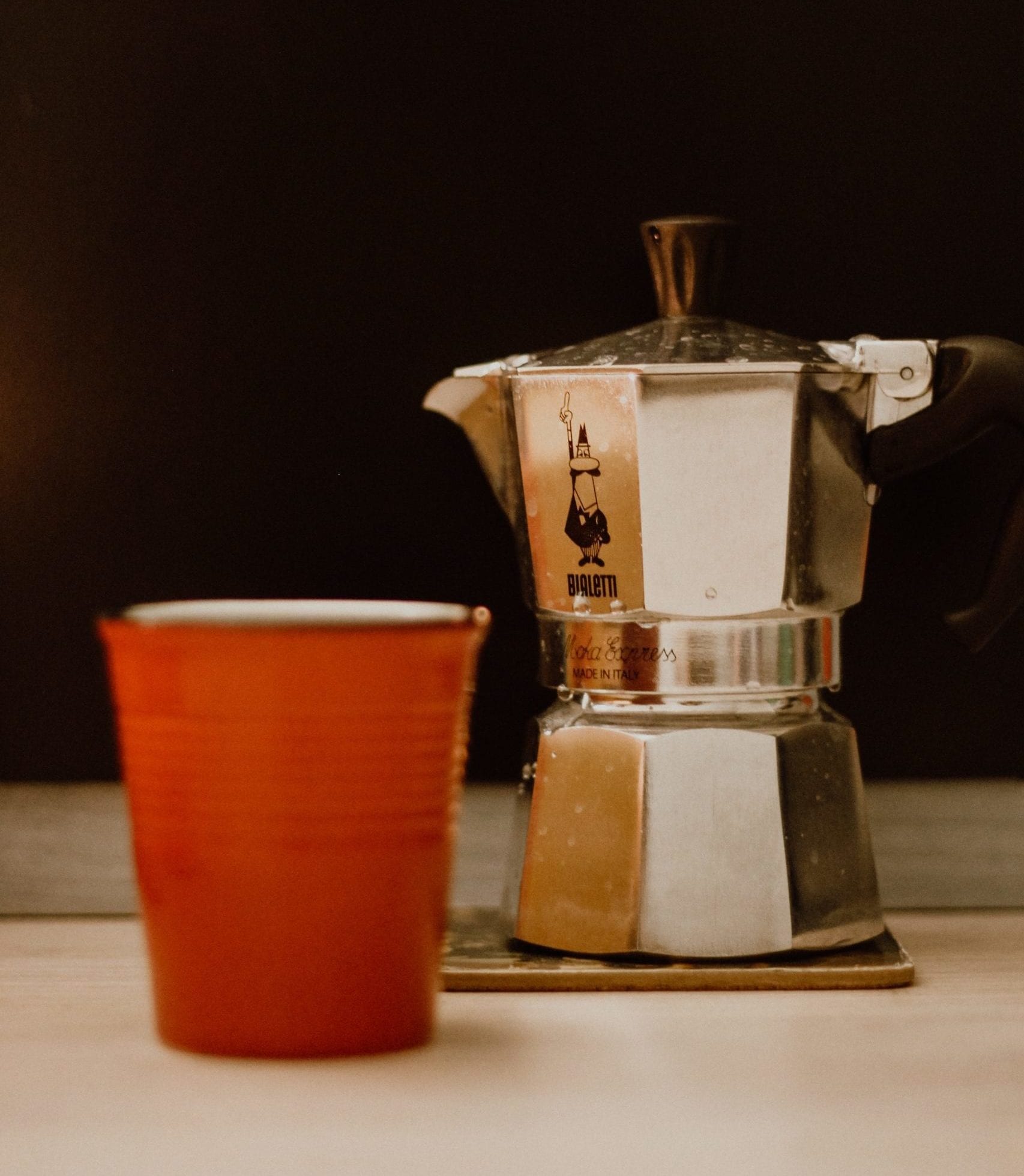
Instructions
- Unscrew the jug and rinse with hot water
- Fill the lower part of the espresso maker with hot water (prevents the pot from heating up too much); leave the valve free
- Put about 20 grams per cup into the sieve insert and press lightly
- screw together and place on the grate or plate
- After about 3 minutes your espresso is ready
Advantages
- Design classics
- perfect espresso enjoyment outdoors
- no waste & easy cleaning
Disadvantages
- more expensive compared to similar models due to the name
- not a real espresso because too little pressure is generated
- more space when packing due to special shape
Option 9: The percolator as a replacement espresso maker for camping
In the functioning similar to an espresso maker the Percolator for cooking a strong, espresso-like coffee while camping or stay overnight at festivals.
The percolator is slightly larger than the conventional espresso pot. The coffee tastes strong and aromatic , the coffee varieties should be chosen accordingly. Light roasts are preferable. Depending on the size, the Weight at one kilogram and more . Prices are between 40 and 80 euros .
Instructions
- Fill water into the jug
- Pour coffee into the powder container
- Place the sieve on the coffee
- Place on a plate or grill with the lid closed
- The steam creates excess pressure, the water drips through the riser tube onto the coffee
Advantages
- No garbage
- Practical to use
Disadvantages
- Additional weight when trekking
- No crema
- Space when packing due to special shape
Coffee preparation without additional material
If you want to avoid any extra weight when traveling and are not too picky about the quality of the coffee, you can simply use hot water and brew the coffee directly in the cup.
Everyone takes a pot, cup and spoon with them when camping. They are part of the basic equipment. If you have to watch the weight of your backpack, you can simply brew your coffee directly. Any kind of beans are suitable for this. There are no additional costs with this method.
Instructions
- Boil water in a pot
- 2 to 4 teaspoons of coffee per cup
- pour in and let the coffee settle
Advantages
- no garbage
- no extra costs
- no weight
- no extra space when packing
Disadvantages
- Be careful with the last sip as the bottom will settle
Camping coffee makers in comparison (price, weight, preparation time)
| Price | Weight | Preparation time | Needed | |
| Travel coffee machine | from 30 €, up to over 500 € | very different | 3 – 12 min | Power connection |
| French Press | 15 to 60 € | from 500g | 5 min | Hot water |
| Vietnamese Phin | from 5 € | from 400g | 5 min | Hot water |
| AeroPress | 30 € | 450g | 3 min | Hot water |
| Filter coffee | depending on the design and model 12 to 90 € | very different | 5 min | Hot water |
| Nanopresso | 60 to 70 € | 350g | 3 min | Hot water |
| Instant coffee | from 1,50 € | depending on portion size | 2 min | Hot water |
| Espresso maker | 20 to 50 € | 240 to 500 g | 4 min | Cooking facilities |
| Percolator | 40 to 80 € | from 1000g | 4 min | Cooking facilities |
Conclusion on the comparison of camping coffee makers
Even if you want to go on holiday in nature, you can still enjoy a good cup of coffee without having to put in a lot of effort. Whether you just want to go on a little trip in your motorhome or are planning pure camping fun in the mountains - making coffee outdoors is no longer a problem with one of these camping coffee makers.
Frequently asked questions (FAQ) about outdoor coffee makers
As a rule, you have two options: either you have access to a power connection or you use the typical camping utensils (classic gas cooker, gas cartridge, smoldering fire, etc.) to prepare your coffee. Depending on the requirements you can, for example, Travel coffee machines, hand filter , French Press , Nanopresso , Espresso maker or other ways to make coffee To fall back on.
The classic variant is boiling water with a gas/camping stove. Once the water is heated, there are various Variations of coffee preparation without electricity like the French Press, the hand filter or even instant coffee. Also for a freshly brewed espresso no electricity access is required.
The exact functionality depends on the type of coffee maker. We give you eight variations of coffee preparation a short step-by-step guide.
It works in a similar way to an espresso maker, but the percolator is a bit larger. The steam generated creates excess pressure in the percolator, causing the water to drip through the riser tube onto the coffee. More about the percolator .

